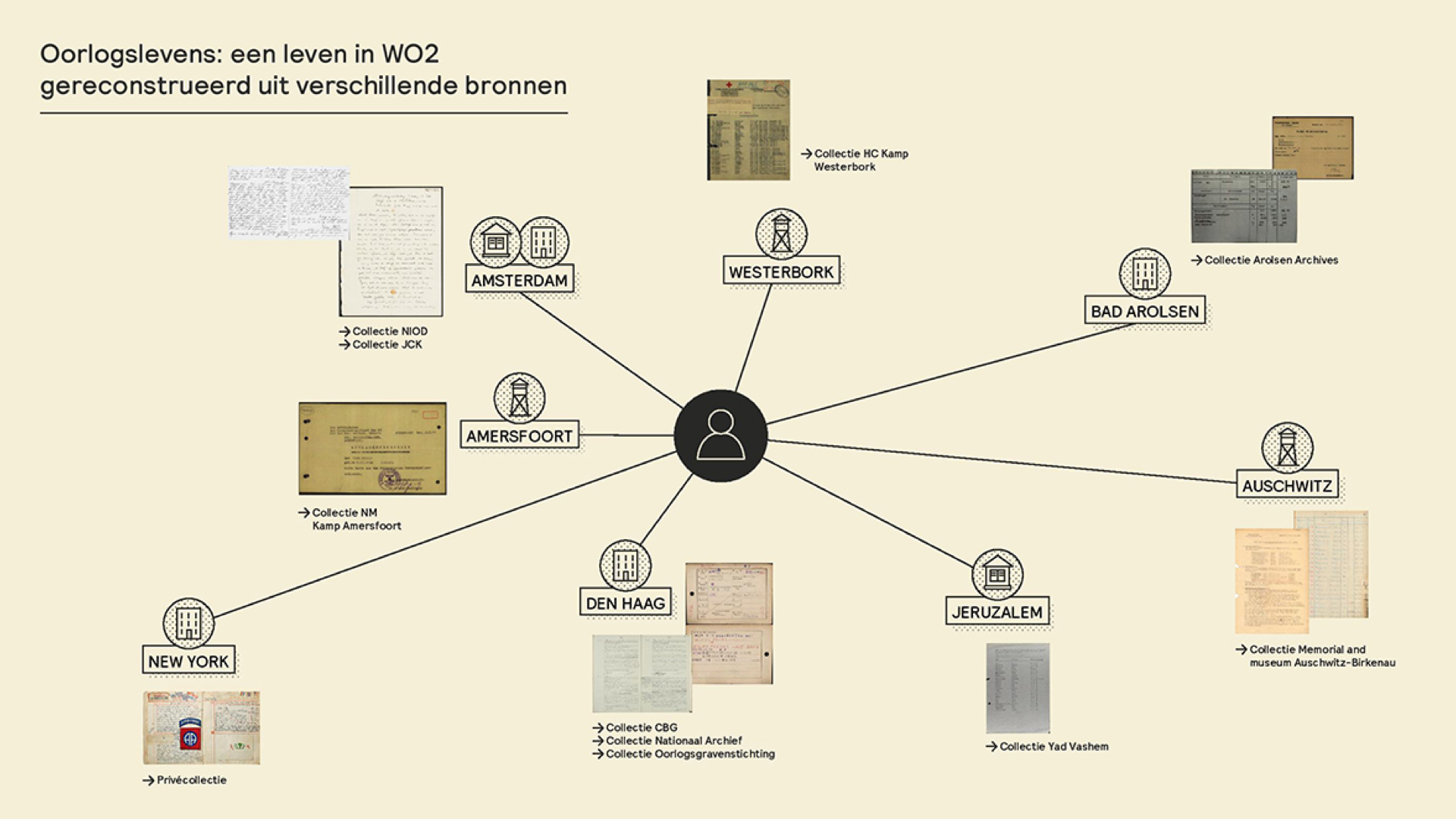To start, can you tell us a little about the project and the inspiration behind it?
World War 2 has been incredibly well documented in millions of pictures, objects, letters, videos, diaries, announcements, newspapers and much more which we call resources. These ‘silent witnesses’ are collected in over 250 different national and international organisations, together they share their collections as a network in Netwerk Oorlogsbronnen. Oorlogsbronnen tells the stories of these resources by placing them into a context where they make sense, like an event, a place, people or themes.
Netwerk Oorlogsbronnen asked us to redesign their current website, in close collaboration with their team, and rebuild it to become the most impressive collection and data-driven website about World War 2. The previous website was a visualisation of the data available, which was built and designed by historians and data scientists. The redesign is created to engage with people generally interested in WW2, culture lovers, (amateur) family researchers and genealogists, historians and for education purposes.
“Historians, data scientists, strategists, developers and designers worked together remotely to see if what we all wanted to make was actually feasible.”
What did the process of developing Oorlogsbronnen look like?
Right after the project started, the world was forced into lockdown due to COVID-19. This meant that almost the whole project was designed and developed from our homes without seeing each other in person. This might have been key to its success. This meant it was easy for anyone to join the daily standup quickly or linger after a daily to brainstorm ideas.
A highly iterative process, Oorlogsbronnen went through several iterations before the first release. We would experiment with the huge sets of data and the knowledge graph to see what would yield the best results. Often, designs made were impossible to realise with the data available but would send us into new and creative ways to handle these variables.
The timelines of a person’s life were a project on their own. A proof of concept was created within a week. Historians, data scientists, strategists, developers and designers worked together remotely to see if what we all wanted to make was actually feasible. The historians would craft a story together with the strategists, the data scientists would check if that data was available, and the designers would design the layout and many fallbacks. The developers would then make a quick mockup to visualise how we can show the data in a compelling way.
What themes or schools of thought influenced the direction of the project?
A recurring theme was not to tell stories but to give context to the events of the Second World War. A resource by itself isn’t relevant to a user. It needs an explanation to be understood. Instead of creating a traditional website that would show a collection of resources or objects by itself, we decided to flip it around. Resources are mainly found through their context. That being a person’s life, a location, an event or a theme.
Who did you have in mind as you were developing Oorlogsbronnen? And what about the project do you think resonated so much with your audience?
The previous website was mainly aimed at “professionals.” Researchers needed these resources as part of their work. However, with this redesign, the main target audience became people generally interested in World War Two or in their own lineage. To bring WW2 into context for these people, we needed to make it highly accessible, personal and easy to navigate. Where a professional researcher would, for example, be interested in archives and copyright, someone looking into their family history wouldn’t be. So we adjusted the design accordingly, still showing the “professional” information when needed but focussing on the ease of use. Focussing on the context of the resource gives everyone a better understanding of the events of WW2.
Did you run into any issues or troubles while developing this project? What steps did you take to overcome them?
With over 12.000.000 resources, over 300.000 persons, hundreds of places, themes and events, data was our biggest hurdle to take. We had to define, document and categorise all the different situations, states and possibilities available. This helped us make a consistent experience. We had to design and develop a fluid system that would handle extreme states of data. Working with fallbacks upon fallbacks, we ensured that whatever data we had would help us tell what happened.
Why did you choose a website as the medium for this project as opposed to others? How did this medium fit your narrative and goal for the project?
A website would be the most accessible medium for all different users. In theory, the features would work in an app or other device, but as it is a platform to browse, research, discover and get lost on, we thought a website would be the ideal medium for it.
Why did you choose to enhance the project with the Articles, People, and Sources pages? What impact did these different resources have on the project as a whole?
The articles give more depth to the events that happened. Without these, there would be no way for a historian to present their research and bind different sources together. Giving a more holistic view of an event and making the connections that can’t be made without them.
People are recognisable and will tell a very personal story of what happened during WW2. This is also the main thing people will search for first; see if they can find someone with their last name and check out what their life was like. Where Articles and People offer users a way to explore and browse without knowing exactly what they are looking for, Sources give people a way into more detailed information. This is the place you go to when you know what you’re looking for or want to know more about something you’ve seen.
What digital tools were instrumental in bringing the project together?
Since most of this project was done remotely, we could not have done this without Miro, Slack and Google Meet. Google Meet for our standups, meetings and quick 1-1’s. Slack for quick questions and other conversations. But Miro was the real game-changer for us. Without it, we could not have done the workshops we did to explore and iterate on our designs. We could literally not have done this project the way we did if we started 5 years ago.
How has your Lovie-winning project impacted your larger work in this field?
This project has opened our eyes to the possibilities of context-driven stories with complex data. Flipping the narrative from the object to its surroundings to explain its significance has proven to have a huge impact on other projects we do for both cultural heritage and museum platforms.
What does winning a Lovie Award mean to you?
Fewer people that actually lived through the Second World War are still alive and are able to tell their stories. Oorlogsbronnen wants to contribute to the telling of these stories to future generations by using actual resources. This enables the War to remain a moral checkpoint in our views on democracy and the rule of law. The Lovie Awards is a recognition that we need to keep learning from the past and not forget what has happened before.









